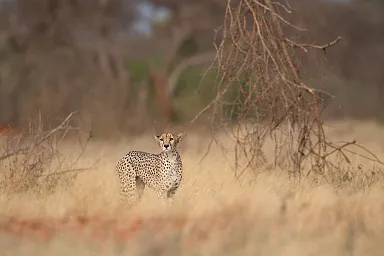
Cheetahs in Tsavo East. Photo courtesy of and copyright ©IngridVekemans. All Rights Reserved.
Cheetah
Species Facts
One of the most specialized cats, the cheetah resembles a sprinter – with a lean body and long legs. This amazing animal is capable of reaching speeds of up to 70 m.p.h. No other land animal can move as fast.
Cheetahs are not aggressive. During confrontation, the cheetah normally applies the flight mechanism as opposed to the fight mechanism. With its weak jaws and small teeth (the price it paid for speed), it cannot fight larger predators to protect its kill or its young.
- Scientific Designation: Acinonyx jubatus
- Related Project: Tsavo Cheetah Project
- Endangered Status: Vulnerable (VU)
- Lifespan: 12 to 14 years (in the wild)
- Weight: 36-64 kg (80-140 lbs)
- Length: 44 to 56 in
- Shoulder Height: 2.5 to 3.0 ft
- Tail Length: 26 to 33 in
Appearance & Build
The cheetah is often mistaken for a leopard. It has long teardrop-shaped lines on each side of the nose, from the corner of its eyes to its mouth. Its coat is tan or buff, with solid black spots that are evenly spaced. There are no spots on its white belly, and the tail has spots that merge to form four to six dark rings at the end. The tail usually ends in a bushy white tuft. Male cheetahs are slightly larger than females and have a slightly bigger head, but it is difficult to tell males and females apart by appearance alone.
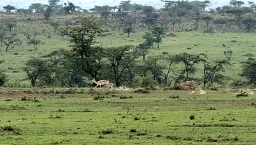
Cheetah in Kenya, 2017. Image courtesy of and copyright © Sharon Osberg of Wild World Foto. Used with permission.
Speed of the Hunt
The cheetah is physiologically and aerodynamically built for speed. Although it has been clocked at approximately 70 m.p.h., no cheetah has run 70 miles in an hour. If a cheetah cannot catch its prey with its characteristic sharp, explosive sprint, it must try again later.
The cheetah is specialized for this explosive speed through many adaptations that make it different from the other members of Order Felidae. It has a powerful heart, an oversized liver, and large, strong arteries. It also has a small head, a reduced muzzle, and enlarged nasal openings. Other specializations include large, powerful thigh muscles, long limbs, a reduced clavicle, and a more flexible spine that contributes to a longer stride length. The cheetah is the only cat with short, blunt, semi-retractable claws. These help grip the ground like cleats for traction when running. The tibia and fibula are tightly bound together to increase stability and the tough paw pads allow the cheetah to make fast, sharp turns while chasing its prey.
Since cheetahs rely on sight for hunting, they are diurnal: more active in the day than night. In warm weather, they move around mostly during the early morning and late afternoon when temperatures are cooler. Cheetahs prey on a variety of species from rabbits to small antelope, in addition to medium-sized ungulates. The cheetah’s hunting technique is to stalk as close as possible to the prey, then to burst into full speed, and then to trip the prey with a front paw. Finally, as the prey falls, the cheetah bites the throat in a strangulation hold.
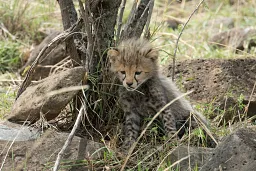
Cheetah cubs in Kenya, 2017. Image courtesy of and copyright © Sharon Osberg of Wild World Foto. Used with permission.
Cheetah Cubs
The fur of newborn cubs is dark and the spots are blended together and barely visible. During the first few weeks of life, a thick yellowish-gray coat (called a mantle) grows along the cub's back. The mantle is thought to have several purposes, including acting as a thermostatic umbrella against rain and the sun, and as a camouflage imitating the dry dead grass as well as allowing the cubs to blend into the shadows. The mantle is also thought to be a mimicry defense, causing the cub to resemble a honey badger. Honey badgers are extremely vicious small predators that most other predators are apt to leave alone. The mantle begins to disappear at about three months, although the last traces of it, in the form of a small mane, are still present at more than two years of age.
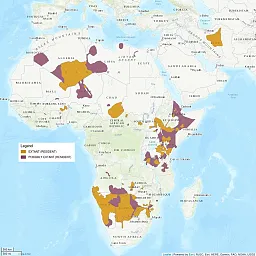
Species Distribution
The cheetah prefers open country, such as grassy plains, open woodlands, and semi-desert. It has been estimated that in 1900 the world had more than 100,000 cheetahs distributed throughout at least 44 African and Asian countries. Today, the species is extinct from more than 20 countries. The 12,000 to 15,000 animals that remain are found mostly in small-pocketed populations in 24 to 26 countries in Africa (plus fewer than 100 individuals in Iran).
Distribution map courtesy of IUCN (International Union for Conservation of Nature), compiled in 2015.
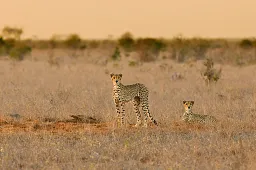
Cheetahs in Tsavo East. Photo courtesy of and copyright ©IngridVekemans. All Rights Reserved.
Threats to the Cheetah
Threats to the cheetah’s survival in the wild include habitat loss, declining prey numbers, and pressure from other species, including the lion, hyena, and the leopard. The cheetah is classified as Vulnerable (VU) by the International Union for Conservation of Nature (IUCN), and is listed in appendix I (which includes species that are most threatened) of the Convention of International Trade in Endangered Species (CITES).
Want to help us research and conserve this species?
Felidae Conservation Fund helps researchers around the world study and protect felids of all sizes.
Make sure you write a comment with "Cheetah" so we can designate 100% of your donation to go to protecting this species.
Do You Have 2-4 Hours A Month To Preserve Your Local Ecosystem?
Our volunteers are the driving force behind making true change in ecosystem health and wild cat conservation. Some like to volunteer in the field, others help us maintain our online presence, and some work with events. With just a few hours a month, you can make a difference, too.
Make A Difference Right Now
As a 501(c)3 nonprofit, our work is only possible because of generous donors like you.
More than 90% of your donation will go directly to our groundbreaking research, outreach, and education programs.
This is where true change starts. If you’d like to be a part of it, make a donation to Felidae Conservation Fund today:
Or,
